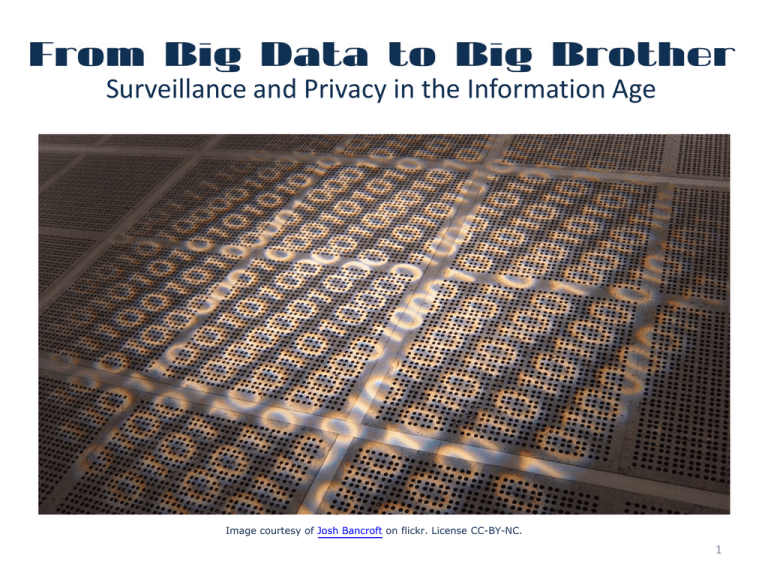
Surveillance and Privacy in the Information Age
Image courtesy of Josh Bancroft on flickr. License CC-BY-NC.
1
Basic attributes (Kitchin, 2014)
•
•
•
•
•
•
•
High-volume
High-velocity
High-variety
Exhaustivity (n=all)
Fine resolution
Relationality
Flexibility
Ref. Bollier, 2010 and Kitchin, 2014
© IBM. All rights reserved. This content is excluded from our Creative Commons
license. For more information, see http://ocw.mit.edu/help/faq-fair-use/.
New York City
Courtesy of Mayor's Office of Data Analytics. Used with permission.
3
Total Information Awareness program
This image is in the public domain.
4
Future Attribute Screening Technology
This image is in the public domain.
5
© John Wiley & Sons, Inc. All rights reserved. This content is excluded from our Creative
Commons license. For more information, see http://ocw.mit.edu/help/faq-fair-use/.
Richard Berk’s algorithm that predicts if a criminal released from jail will be involved
in an homicide.
6
© Google. All rights reserved. This content is excluded from our Creative Commons
license. For more information, see http://ocw.mit.edu/help/faq-fair-use/.
7
© Microsoft. All rights reserved. This content is excluded from our Creative Commons
license. For more information, see http://ocw.mit.edu/help/faq-fair-use/.
8
© NASA. All rights reserved. This content is excluded from our Creative Commons
license. For more information, see http://ocw.mit.edu/help/faq-fair-use/.
NASA Center for Climate Simulation
9
Potential consequences of Big data misuses and
abuses (Bollier, 2010):
•
•
•
•
imperil consumer freedom
imperil civil security
imperil personal privacy
imperil of civil liberties
10
Definition: “systematic monitoring of people or
groups, by means of personal data systems, in
order to regulate or govern their behavior.”
(Degli Esposti, 2014)
Applications:
• Recruitment and retention
• Customer loyalty
• Supply chain efficiency
• Security and risk prevention
11
© Surveillance & Society (Sara Degli Esposti). All rights reserved. This content is excluded from
our Creative Commons license. For more information, see http://ocw.mit.edu/help/faq-fair-use/.
(Ref. Degli Esposti, 2014)
12
Main problems:
• unequal relationship between cie & customers
• happens without our knowledge (panopticon)
(Ref. Degli Esposti, 2014)
13
People could eventually:
•
•
•
•
•
•
•
pay more for health insurance
be excluded from health coverage
be denied a loan
be subjected to profiling or extra scrutiny
be kept in jail
be arrested before committing a crime
be found guilty by association
(Ref. Mayer-Schönberger and Cukier, 2014)
14
Accusing a person of a possible behavior
would:
• negate the very foundation of our justice
(presumption of innocence and
responsibility of people)
• deny human volition and free will
• exonerate us from any responsibility
(Ref. Mayer-Schönberger and Cukier, 2014)
15
Should we accept to limit our individual
freedom and rely on big data analytics for
the common good?
Can big data analytics help us to avoid
gender discrimination and racial profiling?
(Ref. Mayer-Schönberger and Cukier, 2014)
16
Strategies currently in place:
•
•
•
•
notice and individual consent
opting-out
anonymization
hacking privacy violators
(Ref. Mayer-Schönberger and Cukier, 2014)
17
Potential solutions:
• shifting from ‘privacy by consent’ to ‘privacy by
accountability’
• defining new regulations (government or market?)
• redefining the notion of justice to preserve human agency
• opening the access to datasets and algorithms (transparency)
• mandating impartial experts to certify the algorithms and the
interpretations
• blurring datasets (differential privacy)
• specifying how people can disprove a prediction about them
(Ref. Mayer-Schönberger and Cukier, 2014)
18
Potential solutions (Bollier, 2010):
•
•
•
•
•
erasing data after a given period of time
giving to people the right to take possession of their data
limiting data collection to what is needed
favouring self-discipline by introducing new social norms
gaming the system by voluntarily altering our behavior
(Nissenbaum)
• being proactive
19
Paradigm shift – Big data requires researchers to:
• deal with the abundance and embrace messiness
• conduct research with no precise question in mind
• gain insights from data (induction) instead of testing
theories by analyzing data (deduction)
• use hundreds of algorithms instead of selecting one
• stop obsessing with causality and be satisfied with
correlations
(Ref. Kitchin, 2014)
20
Advantages of big data compared to traditional scientific
methods:
• reduces the risk of error and bias associated with
sampling (but can also face problems)
• provides the opportunity to create more dynamic and
sophisticated models (but does not offer certainties)
• helps finding correlations that no theory can identify
(but can lead to serious fallacies)
• allows to consider data once perceived as “noise”
(Ref. Kitchin, 2014)
21
TWO SCHOOLS OF THOUGHT
Empiricist (business):
• Big data can speak for themselves without the need of theories, models or
hypothesis (fallacious)
• Big data analytics are free of human bias. They can be interpreted by
anyone and their meanings transcend contexts (fallacious)
Data-driven science (academia)
• Use of existing theories and concepts to analyze the datasets
• Use of big data to identify good questions and formulate hypothesis
• Use of datasets for answering questions that these datasets were not
designed to answer (problem)
(Ref. Kitchin, 2014)
22
Alternative path suggested by Kitchin (2014):
• Drawing on critical theory to frame how the
research is conducted and how the results are
interpreted.
• Admitting that research is never ideologically
neutral and objective.
• Complementing big data studies with small data
studies.
23
Bollier, David. 2010. The Promise and Peril of Big Data.
Queenstown: The Aspen Institute.
Degli Esposti, Sara. 2014. “When Big Data Meets
Dataveillance: The Hidden Side of Analytics”.
Surveillance & Society, vol. 12, no 2, pp. 209-225.
Kitchin, Rob. 2014. “Big Data, New Epistemologies and
Paradigms Shifts”. Big Data & Society, April-June,
pp.1-12.
Mayer-Schönberger, Viktor and Kenneth Cukier. 2014. Big
Data. New York: Mariner Books.
24
Additional Resources
•
Examples of Big Data:
– Public Health
•
•
•
•
•
•
Flu trends from around the world
Patients Like Me
CareCloud
Mini-Sentinel
23 and me
RateMDs
– Security
• Centrifuge Systems
• TransHeat Application
• Censors in car seats
– Finance & Business
• I Know First - Daily Market Forecast
• FarmVille 2
• The Numbers - Where Data and Movie Business Meet
25
Additional Resources cont.
– Services
• Inrix
• TripAdvisor
• CitySense
– Research
• Marine Explore
26
MIT OpenCourseWare
http://ocw.mit.edu
CMS.701 / CMS.901 Current Debates in Media
Spring 2015
For information about citing these materials or our Terms of Use, visit: http://ocw.mit.edu/terms.

